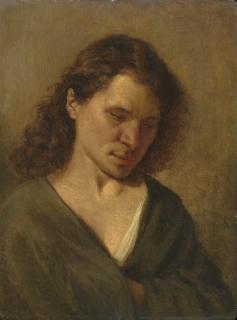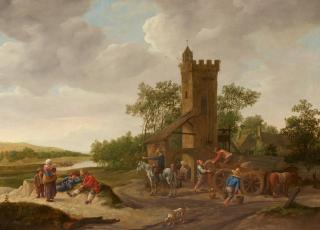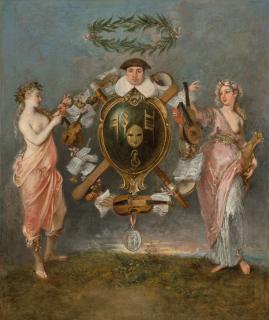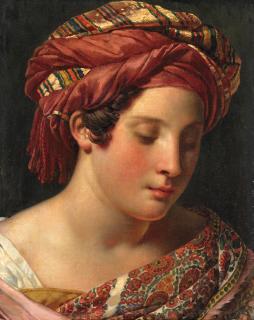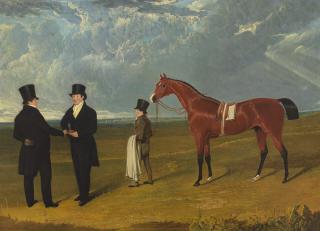
Jan Steen
Portrait d'un homme, en buste
Found at
Christies,
Paris
Maîtres Anciens : Peintures - Sculptures, Lot 30
12. Jun - 12. Jun 2024
Maîtres Anciens : Peintures - Sculptures, Lot 30
12. Jun - 12. Jun 2024
Estimate: XX.XXX
Price realised: XX.XXX
Price realised: XX.XXX
Description
JAN STEEN (1626-1679), PORTRAIT OF A MAN, BUST-LENGTH, OIL ON PANEL
This sensitive depiction of a young man, his eyes lowered, is unique in the work of Jan Steen (1626-1679). Unlike his contemporaries, such as Rembrandt (1606-1669) and Jan Lievens (1607-1674), who produced such figure studies throughout their careers, Steen's oeuvre contains no other examples of this genre.
While his style of execution, the quick, lively brushstrokes, and the model's marked features leave no doubt as to the attribution to the Leiden painter, its unusual subject gives rise to debate about the purpose for which it was produced. Is it an atypical portrait, a sketch for a larger composition, a tronie? Previously known only thanks to its inclusion in the London exhibition of 1952, in the catalogue of which catalogue it was illustrated, successive art historians have put forward various theories on the subject.
Kirschenbaum (op. cit. supra) dates the painting to around 1659. He believed that it might be a study for the head of the kneeling shepherd in The Adoration of the Shepherds, now in the Rijksmuseum (inv. no. SK-A-3509). He also suggests a potential link with the head of Christ, whose figure is disappearing in the Supper at Emmaus (Rijksmuseum, Amsterdam, inv. no. SK-A-1932).
The theory proposed by Braun in 1980 (op. cit. supra) is bolder. He suggested that the present painting was a fragment of a lost work of considerable size, the subject of which was John the Baptist preaching in the desert. It is the case that Hofstede de Groot included in his catalogue raisonné of Steen’s work a large Saint John Preaching that appeared at auction in The Hague in 1747, where it was bought by Graham (C. Hofstede de Groot, A Catalogue Raisonné of the Works of the Most Eminent Dutch Painters of the Seventeenth Century, London, 1908, I, p. 16, no. 29). For Braun, this idea is supported by a comparison with another version of the same subject currently in the collection of the Nivaagaard Museum in Denmark (inv. no. 0053NMK). However, careful examination of the present painting belies this attractive theory, as the panel is bevelled along all four edges.
Wouter Kloek, whom we would like to thank for confirming the attribution to Steen after direct examination of the work, is of the opinion that it could be a study for a more detailed composition. However, he does not rule out the possibility that it is a portrait of someone close to the artist, given its gentle and intimate nature, two adjectives that are rarely the first to be used when describing the work of this usually mischievous artist.
This sensitive depiction of a young man, his eyes lowered, is unique in the work of Jan Steen (1626-1679). Unlike his contemporaries, such as Rembrandt (1606-1669) and Jan Lievens (1607-1674), who produced such figure studies throughout their careers, Steen's oeuvre contains no other examples of this genre.
While his style of execution, the quick, lively brushstrokes, and the model's marked features leave no doubt as to the attribution to the Leiden painter, its unusual subject gives rise to debate about the purpose for which it was produced. Is it an atypical portrait, a sketch for a larger composition, a tronie? Previously known only thanks to its inclusion in the London exhibition of 1952, in the catalogue of which catalogue it was illustrated, successive art historians have put forward various theories on the subject.
Kirschenbaum (op. cit. supra) dates the painting to around 1659. He believed that it might be a study for the head of the kneeling shepherd in The Adoration of the Shepherds, now in the Rijksmuseum (inv. no. SK-A-3509). He also suggests a potential link with the head of Christ, whose figure is disappearing in the Supper at Emmaus (Rijksmuseum, Amsterdam, inv. no. SK-A-1932).
The theory proposed by Braun in 1980 (op. cit. supra) is bolder. He suggested that the present painting was a fragment of a lost work of considerable size, the subject of which was John the Baptist preaching in the desert. It is the case that Hofstede de Groot included in his catalogue raisonné of Steen’s work a large Saint John Preaching that appeared at auction in The Hague in 1747, where it was bought by Graham (C. Hofstede de Groot, A Catalogue Raisonné of the Works of the Most Eminent Dutch Painters of the Seventeenth Century, London, 1908, I, p. 16, no. 29). For Braun, this idea is supported by a comparison with another version of the same subject currently in the collection of the Nivaagaard Museum in Denmark (inv. no. 0053NMK). However, careful examination of the present painting belies this attractive theory, as the panel is bevelled along all four edges.
Wouter Kloek, whom we would like to thank for confirming the attribution to Steen after direct examination of the work, is of the opinion that it could be a study for a more detailed composition. However, he does not rule out the possibility that it is a portrait of someone close to the artist, given its gentle and intimate nature, two adjectives that are rarely the first to be used when describing the work of this usually mischievous artist.


